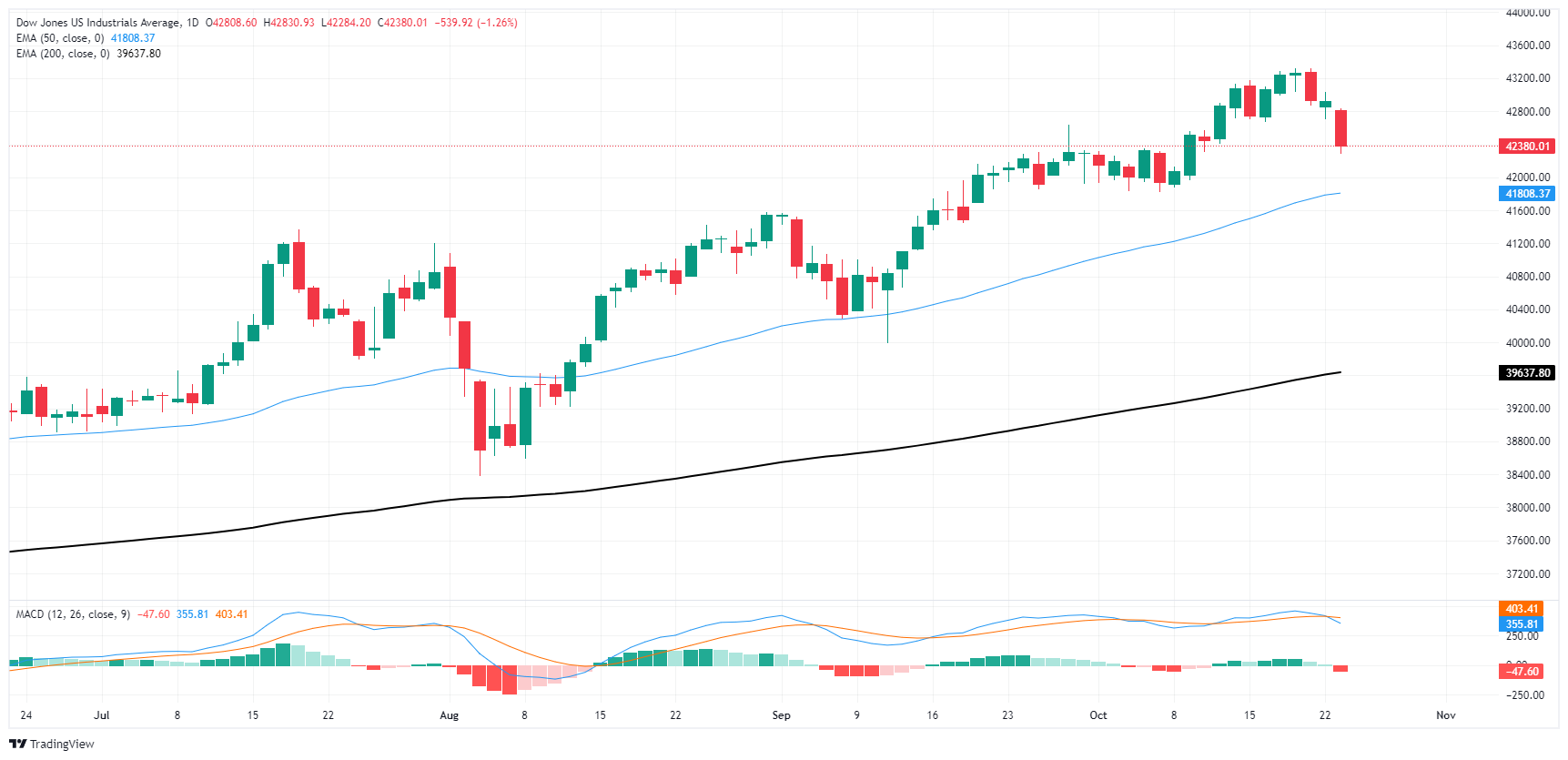- The Dow Jones bottomed out around 550 points lower, or over 1.3% on Wednesday.
- Markets have returned to worrying that interest rates will stick higher for longer.
- Sharp declines in key equities are exacerbating declines.
The Dow Jones Industrial Average (DJIA) is set to grapple with a losing week, something the major equity index hasn’t had to do since August. The Dow turned further bearish on Wednesday, dropping over 550 points at its peak and shedding over 1.3% from the day’s opening bids. The DJIA wrapped up Wednesday 400 points lower, shedding nearly a full percent over the day after a meager recovery from the day's lows.
Despite a jumbo 50 bps rate cut from the Federal Reserve (Fed) in September, markets have again returned to fretting about the possibility of higher-for-longer interest rates. Bond yields stepped higher on Wednesday, prompting an overall decline in equities in a self-fulfilling prophecy: investors worried about the dizzying heights reached by large-cap equities are beginning to pull back from record highs, trimming overbought equities.
Despite US economic data routinely beating expectations, markets remain concerned that the US economy will begin to feel the long-term effects of high interest rates that reached a 16-year peak of 5.5% in 2023. The Fed released some of the pressure in September by trimming rates by half of a percent, but now investors are turned skeptical that the Fed will be pressured into delivering a projected further 50 bps in rate cuts through the remainder of the year.
Dow Jones news
All but five of the Dow’s listed securities are testing into the red on Wednesday, with losses led by food giant McDonald’s (MCD). It is down around 5% and testing below $300 per share after an E. coli outbreak at one of its food suppliers was announced.
Despite a solid earnings report for the third quarter, investors have decided that 3M’s (MMM) quarterly performance isn’t good enough. The Post-it Note producer’s share price declined around 3.5%, falling below $127 per share.
Dow Jones price forecast
The Dow Jones is experiencing a pullback after rallying since late September. Price action has fallen back below the 43,000 handle, though rising support from the 50-day Exponential Moving Average (EMA) remains well below current bids.
The Moving Average Convergence-Divergence (MCAD) indicator is poised for further declines with the histogram crossing back into negative territory. However, a long-run bull market in the Dow Jones leaves oscillating indicators at a notable disadvantage. Traders looking to go short on the Dow should wait for a bearish confirmation and a pullback to minimize upside risks.
Dow Jones daily chart
Dow Jones FAQs
The Dow Jones Industrial Average, one of the oldest stock market indices in the world, is compiled of the 30 most traded stocks in the US. The index is price-weighted rather than weighted by capitalization. It is calculated by summing the prices of the constituent stocks and dividing them by a factor, currently 0.152. The index was founded by Charles Dow, who also founded the Wall Street Journal. In later years it has been criticized for not being broadly representative enough because it only tracks 30 conglomerates, unlike broader indices such as the S&P 500.
Many different factors drive the Dow Jones Industrial Average (DJIA). The aggregate performance of the component companies revealed in quarterly company earnings reports is the main one. US and global macroeconomic data also contributes as it impacts on investor sentiment. The level of interest rates, set by the Federal Reserve (Fed), also influences the DJIA as it affects the cost of credit, on which many corporations are heavily reliant. Therefore, inflation can be a major driver as well as other metrics which impact the Fed decisions.
Dow Theory is a method for identifying the primary trend of the stock market developed by Charles Dow. A key step is to compare the direction of the Dow Jones Industrial Average (DJIA) and the Dow Jones Transportation Average (DJTA) and only follow trends where both are moving in the same direction. Volume is a confirmatory criteria. The theory uses elements of peak and trough analysis. Dow’s theory posits three trend phases: accumulation, when smart money starts buying or selling; public participation, when the wider public joins in; and distribution, when the smart money exits.
There are a number of ways to trade the DJIA. One is to use ETFs which allow investors to trade the DJIA as a single security, rather than having to buy shares in all 30 constituent companies. A leading example is the SPDR Dow Jones Industrial Average ETF (DIA). DJIA futures contracts enable traders to speculate on the future value of the index and Options provide the right, but not the obligation, to buy or sell the index at a predetermined price in the future. Mutual funds enable investors to buy a share of a diversified portfolio of DJIA stocks thus providing exposure to the overall index.
Information on these pages contains forward-looking statements that involve risks and uncertainties. Markets and instruments profiled on this page are for informational purposes only and should not in any way come across as a recommendation to buy or sell in these assets. You should do your own thorough research before making any investment decisions. FXStreet does not in any way guarantee that this information is free from mistakes, errors, or material misstatements. It also does not guarantee that this information is of a timely nature. Investing in Open Markets involves a great deal of risk, including the loss of all or a portion of your investment, as well as emotional distress. All risks, losses and costs associated with investing, including total loss of principal, are your responsibility. The views and opinions expressed in this article are those of the authors and do not necessarily reflect the official policy or position of FXStreet nor its advertisers. The author will not be held responsible for information that is found at the end of links posted on this page.
If not otherwise explicitly mentioned in the body of the article, at the time of writing, the author has no position in any stock mentioned in this article and no business relationship with any company mentioned. The author has not received compensation for writing this article, other than from FXStreet.
FXStreet and the author do not provide personalized recommendations. The author makes no representations as to the accuracy, completeness, or suitability of this information. FXStreet and the author will not be liable for any errors, omissions or any losses, injuries or damages arising from this information and its display or use. Errors and omissions excepted.
The author and FXStreet are not registered investment advisors and nothing in this article is intended to be investment advice.
Recommended content
Editors’ Picks

GBP/USD drops to fresh two-week lows below 1.2900
GBP/USD remains under pressure and trades at a fresh two-week low below 1.2900 in the American session on Wednesday. Soft February inflation data from the UK and the Spring Budget delivered by Chancellor Rachel Reeves weigh on Pound Sterling midweek.

EUR/USD stays below 1.0800 after upbeat US data
EUR/USD struggles to gain traction and trades below 1.0800 in the American session on Wednesday. Upbeat February Durable Goods Orders data from the US support the US Dollar in the second half of the day, making it difficult for the pair to stage a rebound.

Gold clings to modest daily gains above $3,020
Gold fluctuates in a relatively tight range and manages to hold above $3,020 midweek. The precious metal seems to be benefiting from the positive sentiment surrounding the commodities after Copper climbed to a new all-time high earlier in the day.

Bitcoin holds $87,000 as markets brace for volatility ahead of April 2 tariff announcements
Bitcoin (BTC) holds above $87,000 on Wednesday after its mild recovery so far this week. A K33 Research report explains how the markets are relatively calm and shaping up for volatility as the market absorbs the tariff announcements.

Sticky UK services inflation shows signs of tax hike impact
There are tentative signs that the forthcoming rise in employer National Insurance is having an impact on service sector inflation, which came in a tad higher than expected in February. It should still fall back in the second quarter, though, keeping the Bank of England on track for three further rate cuts this year.

The Best brokers to trade EUR/USD
SPONSORED Discover the top brokers for trading EUR/USD in 2025. Our list features brokers with competitive spreads, fast execution, and powerful platforms. Whether you're a beginner or an expert, find the right partner to navigate the dynamic Forex market.